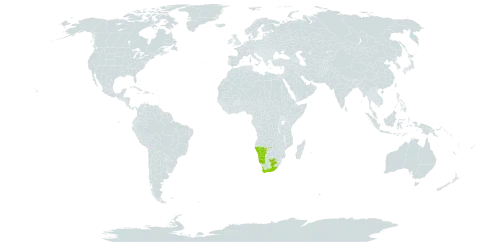Shrub to 2 m tall, densely branched, compact or spreading; bark on basal stems furrowed and ridged, grey to brown; young branches sometimes succulent, glabrous, glaucous, with yellow-green longitudinal striations that branch dichotomously and also anastomose. These striations later, following periderm growth, form the ridges on the bark of older branches. Shorter branches becoming spinose with age, with dry, tapering, pungent apices. Leaves alternate, simple, ciliolate when young, sparcely distributed on younger growth, petiole ca. 1/5 to 1/6 length of leaf, blade succulent, initially somewhat fusiform, terete, tapering more at the distal end, apex acute, 2-5 x 1 mm, caducous, progressively senescing on developmentally older stems, petiole and leaf apex senescing first, eventually followed by the middle portion of the leaf; leaf abscising leaving a persistent brown petiolar stub or sometimes as a whithered whole leaf; lateral branches subtended by one main bract and two transverse ones above. Flowers solitary, peduncle 1.5 mm long, subtended by a bract, at apex with two transversely oriented (with respect to bract), triangular to sublanceolate bracteoles, initially green, becoming brown and squamate, apex acuminate, senescing, margin ciliolate. Flower pedicel 1 mm long, merging gradually into the receptacle. Calyx not differentiated (fused to ovary and hypanthial cup), ca. 6.mm high, bearing a slightly raised, elliptic gland at lobe junctions. Corolla actinomorphic, (4)5-merous, 2.5-3.0 mm wide, corolla tube not present, lobes valvate, triangular, 1-1.5 mm long, uncinate, outer surface glabrous, inner surface without apical trichomes (beard), white. Stamens 5, antipetalous, inserted at junction of disk and corolla, at anthesis reaching only midway to corolla lobes, anther and filament each 0.4-0.5 mm long, anther subbasifixed, dithecal, tetrasporangiate, introrse, connected to corolla by post-staminal trichomes. Pollen heteropolar, tricolpate. Disk lining hypanthium, at rim with distinct rounded lobes alternating with corolla lobes. Style filiform, ca. 0.8 mm long, stigma small, 2-lobed, lobes globose, positioned at ca. the height of the anthers. Ovary inferior, unilocular, placentation free-central with 3 pendulous ovules, placenta contorted with a peg-shaped projection at its apex. Fruit a drupe, pedunculate with persistent, scarious subtending bracteoles, white at maturity, globose to ellipsoid, 5-8 mm long, surface smooth, no reticulum visible, crowned by persistent, scarious, brown corolla lobes. Seed enclosed in a stony endocarp.
More
Rigid, nearly leafless, hemiparasitic shrub, up to 2 m high, with stems grooved, rigid, spine-tipped. Leaves linear, soon deciduous. Inflorescences with solitary flowers in axils of bracts on short peduncles, arranged in racemes on spinescent branchlets. Bracts small, scale-like, triangular. Flowers whitish yellow. Perianth with tube ± 1 mm long; segments triangular, 1.5 mm long, subacute, hooded, margins slightly inflexed. Flowering time Aug.-Apr. Fruit oblong-ellipsoid, ± 8 mm long; not ribbed, with slight reticulation.
Shrub, 0.75-2.00 m high. Stems rigid, grooved, branches spine-tipped, nearly leafless. Leaves linear. Flowers: solitary in axils of bracts on short peduncles, arranged in simple, terminal spike-or raceme-like inflorescences on spinescent branchlets; bracts scale-like, triangular; perianth not bearded, tube 1 mm long, segments triangular, 1.5 mm long, hooded, margins slightly inflexed, white; Jun.-Oct. Fruit oblong-ellipsoid, ± 8 mm long, not ribbed, slightly reticulate.
Rigid, nearly leafless, hemiparasitic shrub, up to 2 m tall, with grooved, rigid, ± upright, spine-tipped stems. Leaves linear, soon deciduous. Flowers mostly solitary in bract axil, arranged in simple, short racemes on spinescent branchlets, whitish, bracteoles similar to bracts and as long as or longer than flowers.
Rigid, nearly leafless, hemiparasitic shrub to 2 m, with stems grooved, rigid, spine-tipped. Leaves linear, soon deciduous. Flowers in short racemes on spinescent branchlets, whitish, bracteoles like bracts and as long as or longer than flowers.
A shrub. It grows 2 m tall. The leaves are alternate and simple. They are 2-5 mm long by 1 mm wide. The flowers occur singly. The fruit is fleshy and 5-8 mm long.
